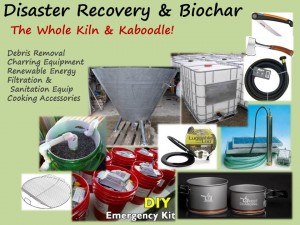The recent devastation in Vanuatu and the availability of low cost biochar producing kilns has spawned some more serious and targeted conversations amongst some of my favorite biochar people in the land down under. Many organizations play critical roles in disaster recovery. One that is especially adept, from what I have recently learned, is Rotary International. They have partnered with Shelterbox to provide temporary housing and other emergency supplies to victims of disaster. Building on the concept of a readymade kit for disaster scenarios, my down under biochar buddy Frank and I pondered what kind of biochar kit would best help victims to convert downed biomass into biochar to be used in different ways. [I’ve previously blogged about this Disaster Recovery and biochar and biochar should be a prepper’s best friend]. Here are some initial thoughts for suitable items.
The core of the kit is a kiln to convert biomass into biochar. While there are many different technologies that could be used to convert downed biomass, I am a big fan of the Kon-Tiki Kiln for several reasons. [Full disclosure, although the development has been open source, it was driven by the Ithaka Institute of which I am a part.] The kiln is low cost (various sizes available but all under <$4K), has low emissions, can handle relatively high moisture feedstock and produces very good biochar as per testing done in Europe. The ability for heat recovery is being tested and will soon be available as well.
Although the kiln doesn’t require biomass to be chipped, trees and limbs do need to fit into the kiln so hatchets and pruning shears are a necessary part of the ‘kaboodle’. Thermoelectric conversion technologies such as the Power Pot X could enable victims and disaster relief workers to not only boil water for both sanitary and cooking purposes but they can also charge phones and other USB accessories. A solar pump will help get the quench water from the tote to the kiln. If the biochar is going to be used as a soil amendment, human urine could be used instead of water so having a few 5 gallon buckets with ‘luggable loo’ tops to divert this ‘waste’ for use as a quenching liquid would be ideal. Another use for the buckets, which could be filled with other emergency supplies to optimize shipping space, is for water filtration. Biochar could make an excellent, locally producible filtration media for emergency relief locations. Cooking accessories such as grills or spit roasts would also make a nice addition to the kit.
Depending on the situation, additional items (e.g. trowels, mixing equipment, brick molds, etc.) could be included that enable different end uses for the biochar such as building materials.
Training on biochar production and various end uses would obviously be required, but once trained, local residents would have the tools to enable their communities and their soils to bounce back.
Perhaps, in honor of the ancient cultures who figured out how to convert their ‘waste’ into highly fertile soils called Terra Preta, we ought to dub the process of converting disaster debris into tools for healing soil and water ‘Disaster Terra P’!


